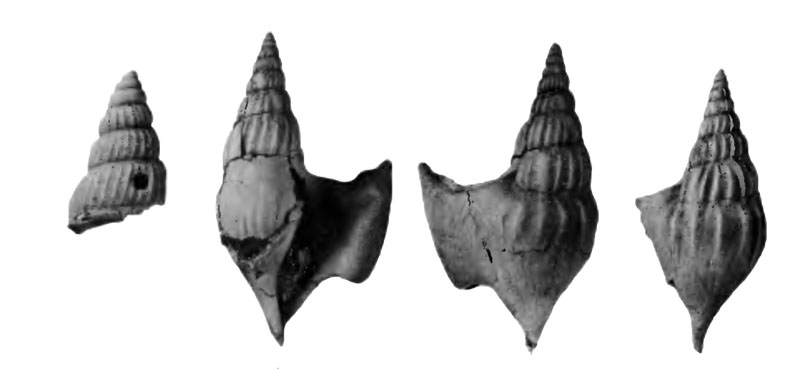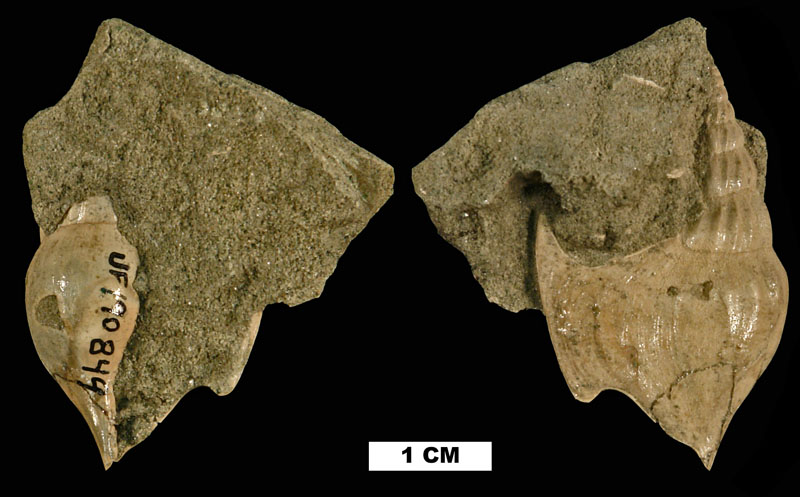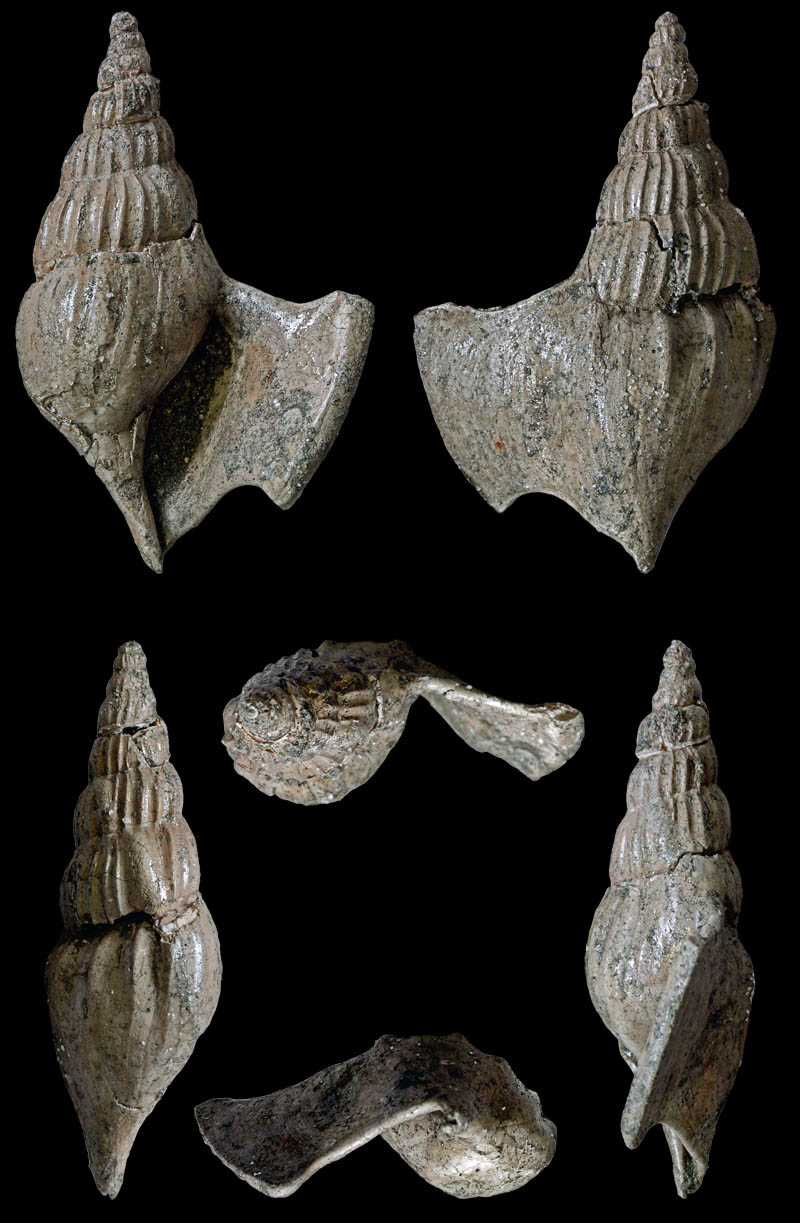|
edit SideBar
|
Stromboidea
Original description of Anchura lobata by Wade, 1926
- "Shell of more than medium size; thin but tough and strong; spire turreted, its elevation a little greater than half the total altitude of the shell; whorls seven, increasing gradually in size, convex, and closely appressed; protoconch small and smooth, trochoid, and coiled three times; sculpture dominantly axial; axial costae abruptly elevated but low, angular on the crest, and protractive, more widely spaced on the body and disappearing near the aperture; low varicose ribs appear at irregular intervals; varices not protractive but parallel to the axis; spiral sculpture consists of fine, crowded, slightly impressed lines on the spire but absent on the body; suture impressed; body inflated and very abruptly constricted in front, where it merges into a narrow, sharp anterior canal; inner aperture lenticular and produced in front into a narrow, straight canal; outer lip expanded into a broad wing-shaped appendage, lobed anteriorly and produced backward into a pointed spur-shaped projection; outer margin slightly thickened; posterior commissure extended backward upon the penultima; inner lip excavated; columella smooth; parietal wall washed with a thin, wide brilliant glaze of callus."
Locus typicus: Dave Weeks place on Coon Creek, McNairy County, Tennessee, USA.
Stratum typicum: Ripley Formation, upper Cretaceous
History and Synonymy
1941
Description of Anchura lobata by Stephenson, 1941:
- "Shell of medium size and thickness. Spire about half the total height of the shell. Whorls seven, slightly convex on the sides, slightly constricted just below the suture, the constriction becoming most pronounced on the penultimate whorl and the body whorl. Suture closely appressed and only moderately impressed. Protoconch as seen on the holotype, small, smooth, trochoid, dextral, coiled three times. The penultimate whorl is ornamented with about 19 somewhat unequal, conspicuous axial ribs whose sides slope moderately forming interspaces wider than the ribs, and whose bottoms form rather sharply concave troughs; most of the ribs are subangular on their crests, but every eighth to tenth rib is a broad, round-crested varix of medium prominence; the ribs become progressively weaker and decrease in number toward the apex; passing from the penultimate to the body whorl the axial ribs become wider apart, at first extending well down over the base, but toward the outer, expanded lip becoming abbreviated and subnodose toward the upper ends; below these short ribs the surface appears smooth and slopes off gently toward the anterior extremity; the whole surface of well preserved shells is covered with delicate, spiral threads so fine they cannot be seen with the unaided eye; these are not wanting on the body whorl of the type, as stated in the original description, although they are more weakly developed, and less completely preserved there than on the spire. Body whorl broadly rounded on the periphery, becoming constricted and smooth anteriorly, and passing into a straight, very narrow canal, which is almost pointed at the terminus. Aperture elongated, produced in front into a long, nearly straight, narrow canal, and less strongly produced posteriorly into a subangular anal canal. The outer lip expands into a broad wing which in the holotype is produced at the outer, upper extremity into a sharp spur, and at the outer lower extremity into a duller, somewhat retreating spur. The upper margin of this wing is produced upward completely across the penultimate whorl; in more mature specimens than the type the margins of the wing become greatly thickened, destroying the sharpness of the spurs. The inner lip is broadly excavated and forms a thin polished callus which spreads conspicuously forward over the base for 5 or 6 mm. from the aperture, and upward past the anal canal to and beyond the suture."
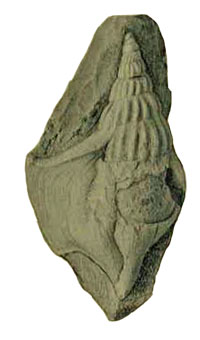 Anchura ? lobata in Stephenson, 1941; Nacatoch sand; near Kaufman, Kaufman County, Texas, USA
- Image courtesy The University of Texas at Austin
Stephenson defined a subspecies:
- Original description of Anchura ? lobata media by Stephenson, 1941:
- "This varietal form is like A. lobata Wade in all essential respects, except that the axial ribs are somewhat more numerous and are sharply developed farther back toward the apex, the constriction below the suture is a little more pronounced, and the average size is somewhat smaller. These differences hold good among a suite of over 20 specimens. The variety is intermediate in size and in the coarseness of its ornamentation between the typical A.? lobata and A.? elegans."
- Locus typicus: North edge of Corsicana, Texas, USA
- Stratum typicum: Nakatoch sand, Navarro Group, Maastrichtian, Cretaceous
- Holotype: U.S.N.M. no. 76909; incomplete at the apex and part of the outer lip broken away: height 34+ mm., diameter exclusive of the outer lip about 12.5 mm.
- Paratypes: U.S.N.M. no. 76910 (figured); incomplete at the apex; height 24+ mm, diameter, including the expanded outer lip, 19 mm. U.S.N.M. no. 76911 (unfigured).
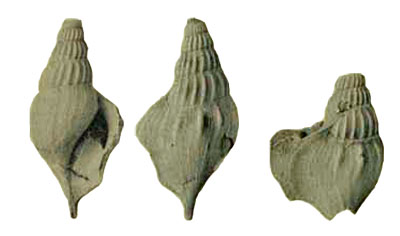 Anchura ? lobata media in Stephenson, 1941; left and middle holotype, right paratype USNM no. 76910
- Image courtesy The University of Texas at Austin
1960
Arrhoges (Latiala) lobata in Sohl, 1960, pl. 11, fig. 9, 13, 14 and 15
- image courtesy of the U.S. Geological Survey
Specimens from institutional collections
Latiala lobata (Wade, 1926); Chapelville Horizon, Coffee Sand Formation, Tupelo Tongue member, Maastrichtian Cretaceous; Baldwyn, Mississippi, USA; Coll. Florida Museum of Natural History UF 190849
Latiala lobata (Wade, 1926); Ripley Formation, upper Cretaceous; Coon Creek, McNairy County, Tennessee, USA; Coll. Stichting Schepsel Schelp no. SSS27029
References:
|



